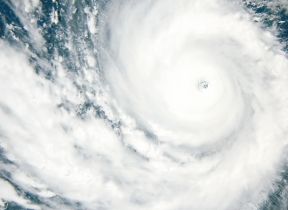Brown ocean effect
When a tropical storm or cyclone makes landfall it usually begins to lose its energy, but sometimes conditions on the land can resemble the moist environment of the ocean maintaining and even increasing the power of the storm.
You may have heard of the 'brown ocean effect' in relation to Tropical Storm 'Bill' which developed on 16 June 2015 across the southern US.
This effect boosted 'Bill' and enabled it to dump phenomenal amounts of rain onto Texas and Oklahoma - perhaps more than would be predicted from this kind of tropical storm or cyclone over land. Significant impacts were produced, for example, flooding and landslides - as the rain followed a record wet May across the two US states.
What is the brown ocean effect?
It is rare, but the brown ocean effect refers to when a tropical storm or cyclone maintains or even intensifies in strength as it moves inland, contrary to the usual behaviour of such systems which tend to fragment and peter out once they make landfall.
As most tropical storms or cyclones get their energy from warm sea water and weaken once they cross the coast and lose their usual source of heat and moisture, and hence energy, from the sea. So for most tropical storms/cyclones the largest amounts of rain are usually recorded before or on landfall.
What does it do?
So why do a few tropical storms or cyclones remain energised or intensify once they make landfall? Recent scientific research has found that three conditions appear to be necessary.
1. The ground must be very warm and have a similar temperature to the sea from where the tropical storm or cyclone has come from.
2. The ground must be very wet or saturated and so this land 'mimics' the sea - and hence the name 'brown ocean effect'. The high amount of moisture in the soil, then allows a high rate of evaporation, which then acts as a source of heat energy for the storm or cyclone, technically known as latent heat - similar to the process over the sea.
3. The amount of this latent heat must be at a certain level - at least 70 watts per square metre. Over the sea it would normally be around 200 watts per square metre.
These conditions were met in Texas and Oklahoma in June 2015. In early summer the ground had warmed up enough, and it was saturated following a record wet May. The latent heat had also reached or exceeded the required level.
The 'brown ocean effect' was first investigated following the 2007 US Tropical Storm 'Erin' when it made landfall across the Texan coast and then intensified as it moved inland over Texas and Oklahoma bringing huge amounts of rainfall.




